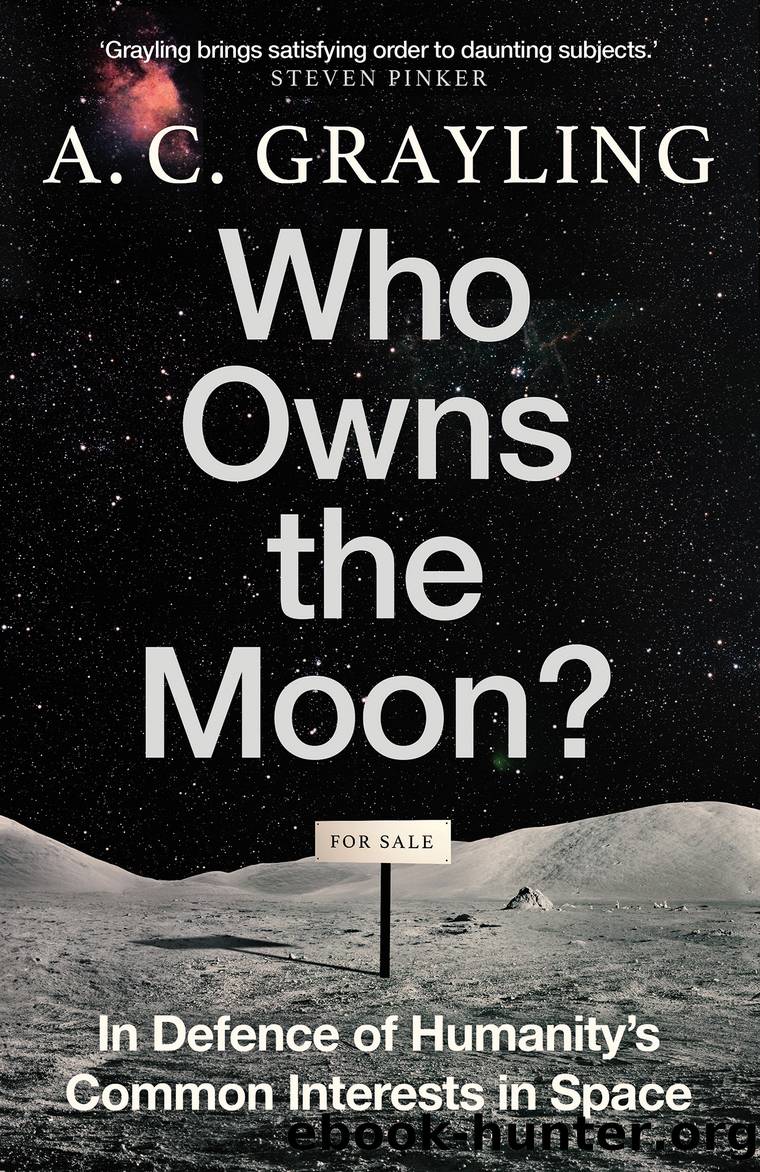Who Owns the Moon? by A. C. Grayling

Author:A. C. Grayling [Grayling, A. C.]
Language: eng
Format: epub
ISBN: 9780861547265
Publisher: Oneworld Publications
Published: 2024-02-05T00:00:00+00:00
Although penetration of the aerial spaces above human heads first happened long ago â in the form of tall buildings such as pyramids, ziggurats, and towers (the tower unearthed archaeologically within the walls of Jericho is dated to 8000 bce), followed after about nine millennia by Chinese-invented rockets for warfare and entertainment (believed to have originated in the Sung Dynasty 960â1279 ce), followed by hot-air balloons in the eighteenth century â it was not until the first decade of the twentieth century that thoughts of a need for a âLaw of Spaceâ were mooted. The prompt was realisation that heavier-than-air flight, and radio transmission, raises questions about whether the airspaces above states are commons like the high seas, or are national territory; and if the latter, how far up into the air national sovereignty extends.
It was a Belgian lawyer, Emile Laude, who asked this question in connection with radio waves, since these travel through the sky above all and any national territory. He observed that âthe problem of the ownership and useâ of radio waves (he called them âHertzian wavesâ) would one day prompt the need for a âLaw of Spaceâ.2 In the years after the First World War the more practical matter of sovereignty over the altitudes accessible to aircraft was a focus of international debate; at a conference on the question in Moscow in 1926 it was taken as read that states have âcomplete sovereigntyâ over their airspace, though the question of âdefining the altitude at which the international zone beginsâ above that airspace was, as the senior Soviet official V. A. Zarzar noted, left unresolved.3 As this shows, it was already recognised that a distinction is needed between airspace and outer space, and the first thorough examination of the implications of that distinction was made by the remarkable lawyer and inventor Dr Vladimir Mandl in a short monograph published in 1932.4
Mandl was both interested in and prescient about the development of rocketry (he himself patented a design for a high-altitude rocket). He saw that a legal regime for space had to be different from both airspace and maritime law, asserting that beyond territorial airspace âthere begins an area which has no relation to our globe and therefore to any individual part of the Earthâs surface, which is no longer Earth appurtenant and is therefore free of any terrestrial State power, coelum liberum. In this area, the traffic of spaceships is completely free.â5 The reference to Grotiusâ concept of mare liberum is direct, and Mandlâs iteration of it underlies the UNâs Resolution 1721 of 1961 stating that âOuter space and celestial bodies are free for exploration and use by all States in conformity with international law and are not subject to national appropriationâ.6
It is easy to make airy and even idealistic generalisations about subject-matters which are in no danger of being imminent realities, but Mandl saw that space was indeed coming within human reach, and with much insight discussed âthe nationality of spaceships, the construction of ports in
Download
This site does not store any files on its server. We only index and link to content provided by other sites. Please contact the content providers to delete copyright contents if any and email us, we'll remove relevant links or contents immediately.
| Air & Space | Construction |
| Disability | Educational Law & Legislation |
| Labor Law | Maritime |
| Military | Personal Injury |
| Sports |
Steroids: History, Science, and Issues by Standora Joan E.; Bogomolnik Alex; Slugocki Malgorzata(1406)
A Practical Guide to International Arbitration in London by Hilary Heilbron(1321)
Last Narco by Beith Malcolm(1282)
Adrift by Steven Callahan(1255)
Reclaiming History by Vincent Bugliosi(1219)
Persuasion by Owner(1209)
The Nuremberg Interviews by Leon Goldensohn(1189)
Poisoned by Jeff Benedict(1170)
Dog Company: A True Story of American Soldiers Abandoned by Their High Command by Lynn Vincent & Roger Hill(1153)
40 Days and 40 Nights by Matthew Chapman(1145)
The New Whistleblower's Handbook by Stephen Kohn(1127)
Introduction to the study and practice of law in a nutshell by Kenney F. Hegland(1099)
Lincoln's Code by John Fabian Witt(1068)
Kafka's Last Trial by Benjamin Balint(1049)
Eichmann in Jerusalem by Hannah Arendt(1032)
A Passing Fury by A. T. Williams(998)
Japanese War Crimes during World War II: Atrocity and the Psychology of Collective Violence by Frank Jacob(992)
Dog Company: A True Story of American Soldiers Abandoned by Their High Command by Roger Hill & Lynn Vincent(969)
A Court of Refuge by Ginger Lerner-Wren & Rebecca A. Eckland(961)
